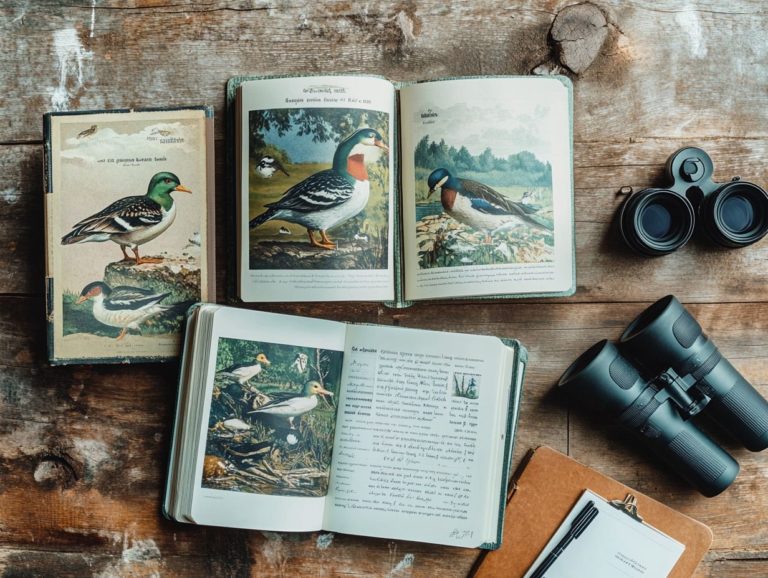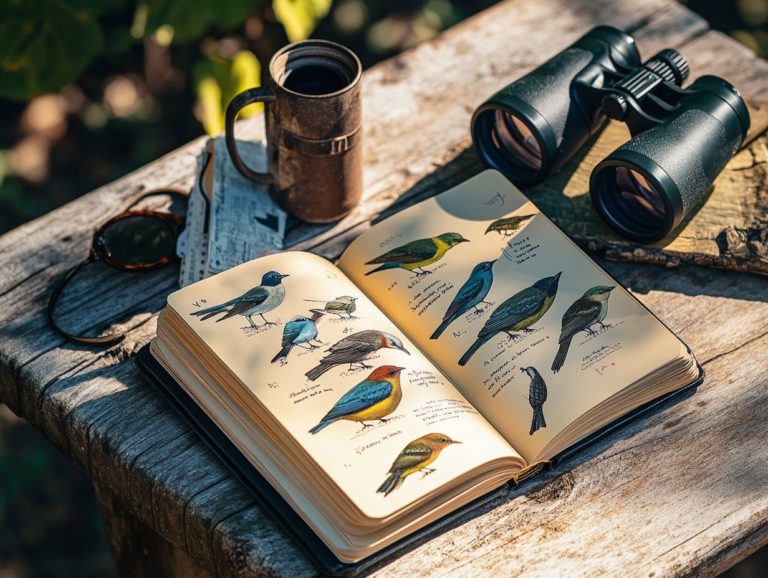Bird Field Guides: Learning from Experts
Bird field guides are your indispensable companions. Whether you’re just starting your birdwatching journey or consider yourself a seasoned enthusiast, they reveal the mysteries of birdlife. You ll find a wealth of knowledge, including insights on local wildflowers and mushrooms.
This article explores the many benefits of these guides. They help sharpen your identification skills and deepen your understanding of bird behavior, habitats, and biodiversity.
Get ready to learn from experienced birders and bird experts! Jump in and discover the exciting world of birdwatching!
Contents
- Key Takeaways:
- Benefits of Using Bird Field Guides
- Choosing the Right Bird Field Guide
- Using a Bird Field Guide Effectively
- Expert Insights and Recommendations
- Frequently Asked Questions
- What are bird field guides and why are they important for learning about birds?
- How can I use a bird field guide to learn from experts?
- What should I look for in a good bird field guide?
- Do I need to be an expert birder to use a bird field guide?
- Can I rely solely on bird field guides for my bird identification skills?
- Are there digital versions of bird field guides available?
Key Takeaways:

- Bird field guides are vital for identifying species and understanding their habits.
- Choose a bird field guide based on range, pictures, and organization to suit your needs.
- Learn effective techniques for using a bird field guide, and seek insights from experienced birders.
What are Bird Field Guides?
Bird field guides serve as important tools crafted by esteemed organizations like the National Audubon Society. They include comprehensive information about birds across North America, helping you, whether a nature lover or a seasoned birder, identify birds effectively.
Packed with detailed information on physical descriptions, ecological insights, and conservation statuses, these guides are a treasure trove of knowledge. You can expect stunning photographs, a visual index, and comprehensive details that make them invaluable educational tools for both newcomers and experienced birdwatchers alike.
Beyond captivating illustrations, these guides delve into crucial insights about each species’ habitats, behaviors, and migratory patterns. They enhance your understanding of the intricate web of ecosystems and shine a light on conservation efforts, often championed by the National Audubon Society, motivating you to participate in preservation initiatives.
Whether you’re a backyard enthusiast or a committed bird expert, these guides, such as exploring bird habitats with field guides, instill a strong sense of responsibility and appreciation for wildlife. They promote ecological awareness and inspire you to take action in protecting bird habitats.
Benefits of Using Bird Field Guides
Using bird field guides opens up amazing advantages for both novice birdwatchers and experienced bird experts. These guides enhance your ability to accurately identify a diverse array of bird species while fostering a profound connection with nature, especially when it comes to understanding bird behavior.
Through guided learning and insightful ecological perspectives, you can deepen your appreciation for the avian world and the ecosystems they inhabit.
Start your birdwatching journey today! Grab a field guide and step outside to discover the wonders of nature!
Improving Identification Skills
Bird field guides significantly elevate your identification skills by offering a user-friendly structure that enables you to quickly reference key characteristics, such as physical descriptions and seasonal changes in bird species. Utilizing these resources can empower both novice and expert birders alike, enhancing your birdwatching experience.
These guides often adopt organized formats that categorize birds by color, habitat, or size. This simplifies the process of finding and identifying the species you encounter and enhances your ability to recognize the variety of birds. For example, while consulting the Sibley Guide to Birds, you might notice the subtle differences in feather patterns between a Ruby-throated Hummingbird and a Broad-tailed Hummingbird. Despite their shared habitats, each displays its own distinctive traits.
As a keen observer, you should pay attention to behaviors such as feeding styles, flight patterns, and vocalizations, which can provide valuable clues to a bird s identity. Utilizing resources like the Peterson Guide to Birds enriches this experience, featuring illustrations that highlight these unique characteristics and transforming every outing into an opportunity to learn and refine your birdwatching skills.
Learning About Bird Behavior and Habitat

Understanding bird behavior and habitat is essential for you as a birdwatcher. Field guides provide rich ecological insights that enable you to recognize how various bird species adapt to their environments and interact with one another, ultimately enhancing your birdwatching experience.
These guides delve into the intricacies of avian life, offering explanations of feeding habits, courtship rituals, and migratory patterns details that can vary significantly even among closely related species. By shedding light on these aspects, bird field guides become invaluable resources for nature enthusiasts like you, seeking to deepen your understanding of wildlife interactions.
This knowledge makes your birdwatching adventures even more exciting! When you cultivate a nuanced appreciation for birds and their ecological roles, you re more likely to advocate for and support conservation efforts, creating a lasting connection with nature that benefits both the environment and society as a whole.
Choosing the Right Bird Field Guide
Choosing the right bird field guide is crucial for enhancing your birdwatching experience. Consider your personal interests, the geographical focus of your observations, and the depth of information you require.
These factors will significantly influence your decision. This choice will affect whether you buy from a local bookstore or prefer the convenience of online ordering for your birding resources.
Factors to Consider
When you’re deciding on which bird field guide to invest in, consider a few key factors: the guide’s comprehensiveness, its ease of use, and whether it benefits from expert collaboration. For a great resource, check out Field Guides: The Art of Birdwatching Simplified. These elements are crucial for ensuring that the guide caters to both novice and experienced birdwatchers alike.
Quality of content matters immensely; clear illustrations, accurate descriptions, and pertinent regional information can elevate your birdwatching experience significantly. A user-friendly layout and accessibility are essential, allowing you to quickly identify species in the field, which makes your adventure all the more rewarding.
Don t overlook ecological relevance, either. Understanding local habitats and conservation issues is vital for practicing responsible birdwatching. Insights from seasoned birders emphasize the importance of community engagement, which enriches the collective experience and fosters an appreciation for the avian diversity in your surroundings.
Using a Bird Field Guide Effectively
To effectively use a bird field guide, you need to become acquainted with its structure and content, utilizing practical tools that enhance your learning styles. This familiarity empowers you to leverage tips and techniques that will enhance your ability to identify various bird species.
Engaging in interactive learning and utilizing practical tools will elevate your birdwatching experience, making it both rewarding and enriching, especially through self-paced courses and digital resources.
Don t wait too long find the perfect guide and start your birdwatching journey today! Grab your field guide today and start exploring the fascinating world of birds!
Tips and Techniques for Identification

Identifying birds can be significantly improved with a few well-chosen tips and techniques, including understanding their bird categories. Start by honing your observation skills to pick up on physical traits, using photographs in guides, and grasping the bird categories that effectively categorize various species.
By focusing on details like plumage color, beak shape, and size, you can easily differentiate between similar species, such as the American Robin and the closely resembling Varied Thrush. This may require more attention to their ecological roles.
Comparing behaviors and vocalizations can also reveal further insights; for instance, the unmistakable call of the Common Loon stands in stark contrast to the melodic song of the Song Sparrow.
Employing field guides, which are books that help you identify birds, that include taxonomic classifications can also streamline your observations. This makes spotting birds like the Goldfinch or the Blue Jay a thrilling adventure!
Together, these strategies enhance both the joy and precision of your birdwatching experience.
Expert Insights and Recommendations
Expert insights and recommendations from seasoned birders and bird experts offer invaluable guidance for anyone eager to enhance their birdwatching skills and deepen their understanding of bird species, including their conservation statuses. A great resource for this is Field Guides: Navigating the World of Birds.
By tapping into this wealth of knowledge, you can elevate your experience and appreciation of the fascinating world of birds. Don’t miss out on this chance to learn and connect with the world of birds!
Advice from Experienced Birders and Bird Experts
Advice from seasoned birders and bird experts can elevate your birdwatching experience, providing practical tips that enhance your appreciation for nature and sharpen your identification skills, especially when using field guides that bridge knowledge gaps in birding.
Drawing from their own journeys, these experienced enthusiasts stress the importance of patience and keen observation. They encourage you to embrace the quiet moments in natural settings, where the subtle sounds and movements reveal the captivating world of birds, often aided by field guides for beginners.
For instance, one expert shares a transformative experience of spotting a rare species after sitting silently for hours, an encounter that not only improved their identification skills but also deepened their connection to the environment.
Through shared stories and insightful guidance, the birdwatching community imparts valuable techniques, such as maintaining a field journal to document sightings and behaviors. This practice fosters a culture of learning and camaraderie among all who partake in this enriching pastime.
Frequently Asked Questions
What are bird field guides and why are they important for learning about birds?

Bird field guides are books or resources that contain information about different bird species, such as their appearance, behavior, and habitats. They are important for learning about birds because they provide a comprehensive and organized way to identify and understand different types of birds.
How can I use a bird field guide to learn from experts?
Bird field guides are created by experts in the field of ornithology, or the study of birds. By using these guides, you can learn from their expertise and knowledge about bird identification, behavior, and more. For the most reliable information, look for field guides that build your birdwatching knowledge written by renowned birders or bird experts.
What should I look for in a good bird field guide?
A good bird field guide should have clear and accurate illustrations or photographs of birds, as well as detailed information about their physical features, habits, and habitats. It should also have a user-friendly layout and be organized in a way that makes it easy to find information quickly.
Do I need to be an expert birder to use a bird field guide?
No, you do not need to be an expert birder to use a bird field guide. These guides are designed for birders of all levels, from beginners to experienced enthusiasts. They are a valuable resource for anyone interested in learning more about birds and their behavior.
Can I rely solely on bird field guides for my bird identification skills?
Bird field guides are an excellent starting point for identifying birds. However, they shouldn t be your only resource.
You should also observe birds in their natural habitat. Learning from experienced birders will help you develop your skills.
Use field guides to supercharge your birding skills!
Are there digital versions of bird field guides available?
Absolutely! There are many digital versions of bird field guides available, like mobile apps and online resources.
These tools can be convenient for birding on the go and accessing a wealth of information in one place.
However, don’t overlook traditional printed field guides, which remain popular and reliable.






